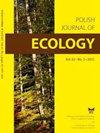野外和森林欧洲狍子牙釉质厚度的差异
IF 0.7
4区 环境科学与生态学
Q4 ECOLOGY
引用次数: 0
摘要
牙釉质是哺乳动物体内最坚硬的组织,由96-98%的无机化合物组成。由于牙列在功能上适应了饮食和摄食行为,牙釉质厚度的相对差异可以反映饮食适应。我们假设欧洲獐牙釉质厚度的差异与栖息地质量对饮食的适应有关。为了验证这一假设,从生活在野外和森林两种栖息地的狍(来自立陶宛- 28颗和波兰- 21颗)的下颌骨中提取了49颗第一恒左下磨牙。结果表明,不论年龄大小,野外生境和森林生境的狍的牙釉质线性厚度(三个不同点牙釉质厚度的平均值)存在差异,野外生境的狍牙釉质更薄(F(1,26) = 6.845, P = 0.025)。这表明在野外和森林生境中,牙釉质厚度对不同类型的日粮有一定的适应性。另一方面,来自野外栖息地的狍也可能更容易受到压力,因为隐藏的可能性较低,或者更容易受到潜在威胁。更频繁的压力暴露会显著破坏成釉细胞的分泌,从而影响牙釉质的厚度。本文章由计算机程序翻译,如有差异,请以英文原文为准。
Enamel Thickness Differs between Field and Forest European Roe Deer Capreolus capreolus
ABSTRACT Dental enamel is the hardest tissue of the mammalian body, consisting of 96–98% inorganic compound. As the dentition is functionally adapted to diet and feeding behaviour, relative differences in enamel thickness can reflect dietary adaptations. We hypothesize that differences in enamel thickness are related to adaptation for diet associated with habitat quality dwelling of European roe deer Capreolus capreolus. To test this hypothesis, 49 first permanent left lower molars were extracted from the mandible of roe deer (from Lithuania – 28 and Poland – 21 molars) inhabiting two type of habitats: field and forest. The linear thickness of total enamel (mean value of enamel thickness measured at three different points) was found to differ between the roe deer from the field and forest habitats, irrespective of age, with the animals of field ecotype tend to have thinner enamel (F(1,26) = 6.845, P = 0.025). This suggests that there is an adaptation in enamel thickness to various types of diet in the field and forest habitat. On the other hand, roe deer from the field habitat can be also more exposed to stress, due to the lower possibility to hide or are more vulnerable to potential threats. More frequent exposure to stress can significantly disrupt ameloblasts secretion and thus affect the thickness of the enamel.
求助全文
通过发布文献求助,成功后即可免费获取论文全文。
去求助
来源期刊

Polish Journal of Ecology
环境科学-生态学
CiteScore
1.10
自引率
0.00%
发文量
9
审稿时长
18-36 weeks
期刊介绍:
POLISH JOURNAL OF ECOLOGY (formerly Ekologia polska) publishes original scientific research papers dealing with all aspects of ecology: both fundamental and applied, physiological ecology, evolutionary ecology, ecology of population, community, ecosystem, landscape as well as global ecology. There is no bias regarding taxons, ecosystems or geographical regions.
 求助内容:
求助内容: 应助结果提醒方式:
应助结果提醒方式:


